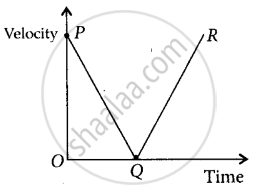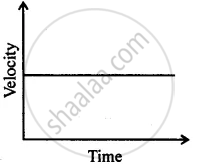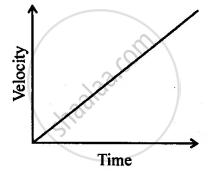Advertisements
Advertisements
प्रश्न
Draw a velocity versus time graph of a stone thrown vertically upwards and then coming downwards after attaining the maximum height.
उत्तर
When a stone is thrown vertically upwards, its velocity at the highest point is zero. As acceleration due to gravity (g) acts vertically downwards, so the upward motion of stone is uniformly decelerated and the downward motion is uniformly accelerated. This makes the velocity of stone while reaching ground equal to the initial velocity of stone. So the velocity-time graph will look like this.

Here, PQ corresponds to upward motion and QR corresponds to the downward motion of the stone.
APPEARS IN
संबंधित प्रश्न
Name the quantity which is measured by the area occupied under the velocity-time graph.
A motorcycle moving with a speed of 5 m/s is subjected to an acceleration of 0.2 m/s2. Calculate the speed of the motorcycle after 10 seconds, and the distance travelled in this time.
A train travelling at 20 m s-1 accelerates at 0.5 m s-2 for 30 s. How far will it travel in this time ?
Derive the formula : v = u + at, where the symbols have usual meanings.
Derive the formula s= `ut+1/2at^2` , where the symbols have usual meanings.
A car acquire a velocity of 72 km per hour in 10 second starting from rest. Find
(1) the acceleration,
(2) the average velocity, and
(3) the distance travelled in this time.
The velocity-time graph of a body in motion is a straight line inclined to the time axis. The correct statement is ___________
Derive the following equations for uniformly accelerated motion:
(i) v = u + at
(ii) `"S = ut" + 1/2 "at"^2`
(iii) v2 = u2 + 2aS
where the symbols have their usual meanings.
Can you suggest a real-life example about the motion of a body from the following velocity – time graph?

Can you suggest a real-life example about the motion of a body from the following velocity – time graph?

